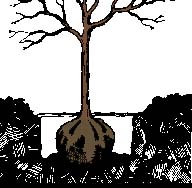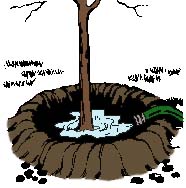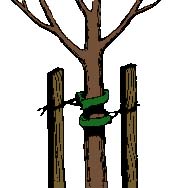Select a site that is in full sun. Dig the hole twice as wide as the root ball (container), and no deeper than the height of the root ball. The soil that you dig out of the hole is what you use to backfill around the root ball. No soil amendments are recommended when planting a tree; Therefore, no compost, peat moss, or shredded pine bark should be added to the backfill.
After planting the tree, build a 4-inch tall berm around the edge of the hole. Fill the berm with a mulch (i.e. shredded bark or compost). The mulch and berm make it easier to water the tree and reduce weed competition.
For most trees, staking is not recommended; however, if the tree trunk is not sturdy enough, use two stakes, one on either side of the tree, and give the trunk support for the first year only. Below are diagrams of a typical tree planting.
Right after planting, water the tree in by filling the bermed basin with water. This will settle the existing soil around the root ball. For the first week after planting, lightly water the tree every day (about one pint to one quart of water each day). The second week, water every other day with about one to two quarts of water. During week three, water every third day with two to three quarts of water. Week four and beyond, water once a week if needed. The goal is to wean the tree slowly off of supplemental irrigation, and produce a root system large enough for the tree to thrive on natural rainfall.
REMEMBER: These are just guidelines. Use your index finger to check the soil moisture under the mulch. If the soil is cool to the touch, do not water. If it is warm and dry, then water. More plants are killed by over-watering than by under-watering.



The information given herein is for educational purposes only. Reference to commercial products or trade names is made with the understanding that no discrimination is intended and no endorsement by the Texas AgriLife Extension Service is implied.
Educational programs of the Texas AgriLife Extension Service are open to all people without regard to race, color, sex, disability, religion, age, or national origin.
Publication Revised November 2008

